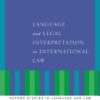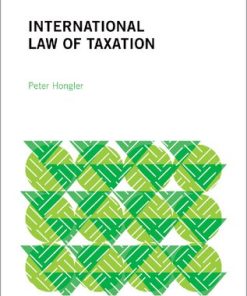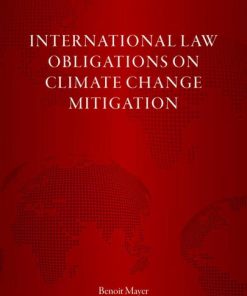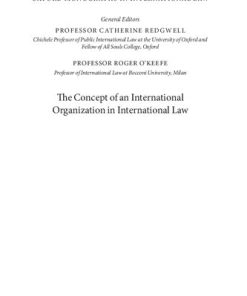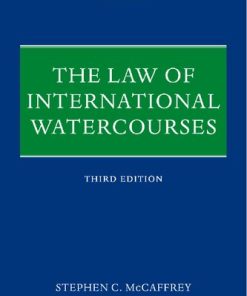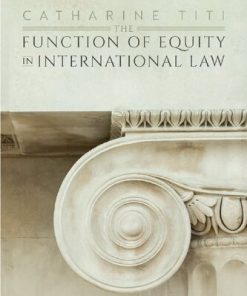The Many Paths of Change in International Law 1st edition by Nico Krisch, Ezgi Yildiz 0198877927 9780198877929
$50.00 Original price was: $50.00.$25.00Current price is: $25.00.
The Many Paths of Change in International Law 1st edition by Nico Krisch, Ezgi Yildiz – Ebook PDF Instant Download/DeliveryISBN: 0198877927, 9780198877929
Full download The Many Paths of Change in International Law 1st edition after payment.
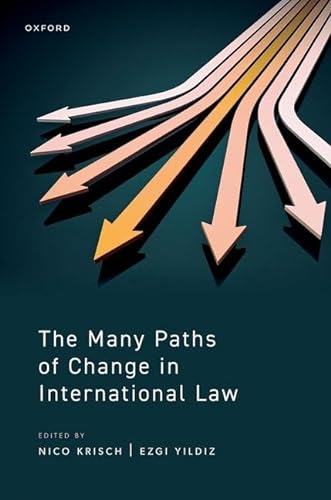
Product details:
ISBN-10 : 0198877927
ISBN-13 : 9780198877929
Author : Nico Krisch, Ezgi Yildiz
How does international law change? How does it adapt to meet global challenges in a volatile social and political context? The Many Paths of Change in International Law offers fresh, theoretically informed, and empirically rich answers to these questions. It traces drivers, conditions, and consequences of change across the different fields of international law and paints a complex and varied picture very much in contrast with the relatively static imagery prevalent in many accounts today. Drawing on inspirations from international law, international relations, sociology, and legal theory, this book explores how international law changes through means other than treaty-making. Highlighting the social dynamics through which different areas and institutional contexts have generated their own pathways, it presents a theoretical framework for tracing change processes and the conditions that affect their success. Based on this framework, each contribution illuminates the paths of change we observe in contemporary international law. The explorations centre on strategies, forms, forces, and social contexts and draw on primary source material and in-depth case studies. Overall, the volume offers a fascinating account of an international legal order in flux-with a dynamic not captured through traditional doctrinal lenses-and helps situate change processes and their varied implications in international law and politics. A relevant book for everyone wanting to understand change and its consequences in international law. This is an open access title. It is made available under a Creative Commons Attribution-Non Commercial-No Derivatives 4.0 International licence. It is available to read and download as a PDF version on the Oxford Academic platform.
The Many Paths of Change in International Law 1st Table of contents:
I. Introduction
1. The Many Paths of Change in International Law: A Frame (Nico Krisch and Ezgi Yildiz)
1. Introduction
2. Change and Stasis in International Law
3. The Process of Change
3.1 Practices and Authorities
3.2 Pathways
3.3 Stages
4. Conditions of Change
4.1 State Positions
4.2 Norm Properties
4.3 Institutional Support
4.4 Discursive Openings
4.5 Combined Effects
5. The Structure of the Volume
5.1 Strategies of Change
5.2 Forms of Change
5.3 Forces of Change
5.4 Situating Change
6. Conclusion
II. Strategies of Change
2. Trump as a Change Agent in International Law: Ends, Means, and Legacies (Mark A Pollack)
1. Introduction
2. Change Agents in International Law: Ends, Means, and Legacies
2.1 Ends and Means: Traditional versus Hostile Change Agents
2.2 Legacies: Why Attacks on International Law May be Path-Dependent
3. The Trump Administration and International Trade Law: Four Case Studies
3.1 Threats and Renegotiation: From NAFTA to USMCA
3.2 Exit: Leaving the TPP
3.3 Systematic Non-compliance: The US-China Trade War
3.4 Attacking International Legal Institutions: The WTO Appellate Body
4. Conclusion
3. Norm-instability as a Strategy in International Lawmaking: The Case of Self-defence against Non-state Actors (Pedro Martínez Esponda)
1. Introduction
2. The Historical Trajectory of Self-defence against Non-state Actors
3. Strategies of Norm-destabilization
3.1 Multilateral Ambiguity
3.2 Selective Protest
3.3 Compromised Support
3.4 Cryptic Precedent
4. Norm-destabilization in International Politics
5. Conclusion
4. Transnational Lawmaking Coalitions as Change Agents in International Law (Nina Reiners)
1. Introduction
2. Interpretation and Change Agents in International Law
3. Transnational Lawmaking Coalitions and Change
4. Change Agents in Action: Two Case Studies of Human Rights Treaty Interpretation
4.1 General Comment No 23, CESCR
4.2 General Comment No 36, Human Rights Committee
5. Conclusion
III. Forms of Change
5. Tracing International Legal Change in Genocide Prevention (Tonya Putnam)
1. Introduction
2. A Few Theoretic Parameters
2.1 Research Design and Case Selection
3. ‘Prevention’ and the Genocide Convention
3.1 Getting to a Legal Prohibition on Genocide
3.2 Developing Authority and Expertise to Address Threats
3.3 Taking on Genocide Prevention
3.4 Reframing (and Re-taming) Genocide Prevention
4. Conclusion
6. The Making of Lawmaking: The ILC Draft Conclusions on the Identification of Customary Law (Wouter Werner)
1. Introduction
2. Codification as Pathway of Change
2.1 From Progressive Development to Codification
2.2 The Turn to Restatements More Broadly: The Example of IHL Manuals
2.3 The Transformative Power of Restatements
3. The Draft Conclusions on the Identification of Customary Law
3.1 The Special Nature of the Draft Conclusions
3.2 Method, Authority, and the Development of Customary Law
4. Conclusion
7. The Turn to Metrics in International Environmental Law (Jaye Ellis)
1. Introduction
2. Promoting the Dynamism of IEL
2.1 Forms of Dynamism in IEL
2.2 Alternate Pathways
3. Turn to Metrics
3.1 Metrics and Authority
4. The Paris Agreement
4.1 Procedural Obligations
4.2 Compliance in the climate change regime
5. Conclusion
IV. Forces of Change
8. Resurgent Authoritarianism, Rights, and Legal Change (Wayne Sandholtz)
1. Introduction
2. Resurgent Authoritarianism and the ‘Zone of Liberalism’
3. Authoritarianism and the International Human Rights Regime
4. Authoritarianism and Domestic Rights Accountability
5. The Resilience of Rights
6. Conclusion
9. The Future of the Oceans: The Role of Human Rights Law and International Environmental Law in Shaping the Law of the Sea (Seline Trevisanut)
1. Introduction
2. Protecting Humans in Search and Rescue Operations
2.1 The International Legal Framework of Search and Rescue Services
2.2 The UNHCR and the Development of the Search and Rescue Legal Framework
3. Protecting the Environment in Offshore Energy Operations
3.1 Sectoral and Geographical Fragmentation
3.2 Unconventional Lawmaking by the IMO and Global Treaty Bodies
3.3 Unconventional Lawmaking by Regional Seas Treaties Bodies
3.4 Unconventional Lawmaking by Unconventional Actors
4. Conclusion
10. World Trade Law and the Rise of China: Struggles over Subsidy Rules (Nina Teresa Kiderlin)
1. Introduction
2. China’s Challenge to International (Trade) Law
3. Generating Trade Law and Litigation Capacity
4. Subsidies and State-Owned Enterprises in China
5. Subsidy Regulation at the WTO
6. Shifts in the WTO Case Law
7. Conclusion
V. Situating Change
11. The Appellate Body’s Judicial Pathway: Precedent, Resistance, and Adaptation (Jeff Kucik and Sergio Puig)
1. Introduction
2. Precedent and the Competing Incentives of International Courts
2.1 The Use of Precedent and the Judicial Path
2.2 Exploring the Judicial Path through Non-compliance
2.3 Change and Adaptation of Precedent
3. Testing Change by Looking at Adaptation
3.1 Design
3.2 Results
4. The Judicial Path and Precedent
4.1 The Paths Framework and Judicial Change
4.2 The AB and Judicial Change
5. Conclusion
12. Whose International Law is Changing? The Practice of Fragmented Communities Constructing Legal Change (Dorothea Endres)
1. Introduction: A Trajectory of Change?
2. CoPs Changing International Law
2.1 Definition
2.2 CoPs in International Law
3. Three Kinds of Communities
3.1 Convergent Community
3.2 Diverging Communities
3.3 Parallel Communities
4. Conclusion: How to Determine Whose International Law is Changing?
13. A Quiet Revolution in the Making? The Changing State Authority in Treaty Interpretation (Fuad Zarbiyev)
1. Introduction
2. Assessing the Interpretive Authority of States
3. Anatomy of a Revolution in the Making
4. Conclusion
14. The Path not Taken: On Legal Change and its Context (Ingo Venzke)
1. Introduction
2. Situating Contingency
2.1 Idealism
2.2 Realism
2.3 Contingency
3. Law’s Autonomy and Reasons for Change
3.1 Legal Reasoning
3.2 Real Reasons
3.3 Which Reality? An Example of Reasons for Change
4. Context All the Way?
4.1 What Makes a Difference?
4.2 The Indeterminacy of Context
4.3 Ex-post Rationalization and Historical Emplotment
5. Conclusion
VI. Epilogue
15. Epilogue: Fragmentary Thoughts on Informal Change (BS Chimni)
1. Introduction
2. Informal Change and the Relative Autonomy of International Law
3. The Direction of Informal Change
4. Conclusion
People also search for The Many Paths of Change in International Law 1st:
what are the different ways of changing a government
changing paths in life
the change path model
a different path for everyone
many paths to spirituality
Tags: The Many Paths, Change, International Law, Nico Krisch, Ezgi Yildiz
You may also like…
Jurisprudence & Law
International Law of Taxation (Elements of International Law) Peter Hongler 9780192653901 0192653903
Jurisprudence & Law - Foreign & International Law
International Law Obligations on Climate Change Mitigation Benoit Mayer
Jurisprudence & Law - General & Miscellaneous Law
Politics & Philosophy - Anthropology
Jurisprudence & Law - General & Miscellaneous Law
Business & Economics - Professional Finance
Credit Intelligence & Modelling: Many Paths through the Forest of Credit Rating and Scoring
Politics & Philosophy - Anthropology


